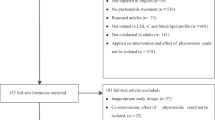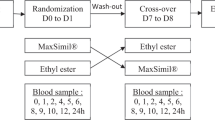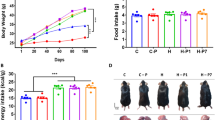Abstract
Objective: This study was performed to investigate the difference in the serum-cholesterol- and triglyceride-lowering activities between phytosterols dissolved in diacylglycerol (PS/DG) and dispersed in triacylglycerol (PS/TG). The effects of the solvent on the concentrations of serum β-sitosterol and campesterol were examined.
Design: The study had a randomised crossover design.
Subjects: Twelve healthy normocholesterolemic or moderately hypercholesterolemic men aged 29–50 y participated in this study.
Interventions: For 2 weeks before the test period (designated as the control period), all subjects consumed control mayonnaise (PS free) daily with supper and were randomly assigned to two groups for the 2 week test period; one group was given mayonnaise containing PS (500 mg/day) dissolved in DG (10 g/day), and the other mayonnaise containing PS (500 mg/day) dispersed in TG (10 g/day). After a wash out period consuming control PS-free mayonnaise for 4 weeks, the groups were reversed for 2 weeks.
Results: PS/TG feeding had no effect on the serum cholesterol level. In contrast, PS/DG feeding significantly reduced the total and LDL cholesterol levels from the initial value of 5.57 to 5.31 mmol/l (4.7%; P<0.05) and from 3.69 to 3.39 mmol/l (7.6%; P<0.05), respectively. Moreover, the degree of total cholesterol reduction induced by PS/DG feeding in the test period was significantly greater than that induced by PS/TG feeding (P<0.05). In addition, the serum β-sitosterol and campesterol concentrations did not change during the PS/TG or PS/DG feeding periods.
Conclusions: Dissolution of PS in DG had a better serum cholesterol lowering effect than dissolution in TG.
Sponsorship: Kao Corporation.
European Journal of Clinical Nutrition (2001) 55, 513–517
This is a preview of subscription content, access via your institution
Access options
Subscribe to this journal
Receive 12 print issues and online access
$259.00 per year
only $21.58 per issue
Buy this article
- Purchase on Springer Link
- Instant access to full article PDF
Prices may be subject to local taxes which are calculated during checkout
Similar content being viewed by others
References
Child P & Kukis A (1983) Critical role of ring structure in the differential uptake of cholesterol and plant sterols by membrane preparations in vitro J. Lipid Res. 24 1196–1209
Child P & Kukis A (1986) Investigation of the role of micellar phospholipid in the preferential uptake of cholesterol over sitosterol by dispersed rat jejunal villus cells Biochem. Cell. Biol. 64 847–853
D'Alonzo RP, Kozarek WJ & Wade RL (1982) Glyceride composition of processed fats and oils as determined by glass capillary gas chromatography J. Am. Oil. Chem. Soc. 59 292–295
Friedewald WT, Levy RI & Fredrickson DS (1972) Estimation of the concentrations of low density lipoprotein cholesterol in plasma, without use of the preparative ultracentrifuge Clin. Chem. 18 499–502
Gylling H & Miettinen TA (1994) Serum cholesterol and cholesterol and lipoprotein metabolism in hypercholesterolaemic NIDDM patients before and during sitostanol ester-margarine treatment Diabetologia 37 773–780
Heinemann T, Leiss O & von Bergmann K (1986) Effects of low-dose sitostanol on serum cholesterol in patients with hypercholesterolemia Atherosclerosis 61 219–223
Heinemann T, Axtmann G & von Bergmann K (1993) Comparison of intestinal absorption of cholesterol with different plant sterols in man Eur. J. Clin. Invest. 23 827–831
Hendriks HFJ, Weststrate JA, van Vliet T & Meijer GW (1999) Spread enriched with three different levels of vegetable oil sterols and the degree of cholesterol lowering in normocholesterolaemic and mildly hypercholesterolaemic subjects Eur. J. Clin. Nutr. 53 319–327
Ikeda I & Sugano M (1983) Some aspects of mechanism of inhibition of cholesterol absorption by β-sitosterol Biochim. Biophys. Acta 732 651–658
Ikeda I, Tanaka K, Sugano M, Vahouny GV & Gallo LL (1988) Inhibition of cholesterol absorption in rats by plant sterols J. Lipid Res. 29 1573–1582
Jones PJH, MacDougall DE, Ntanious F & Vanstone CA (1997) Dietary phytosterols as cholesterol-lowering agents in humans Can. J. Physiol. Pharmac. 75 217–227
Jones PJH, Ntanios FY, Raeini-Sarjaz M & Vanstone CA (1999) Cholesterol-lowering efficacy of a sitostanol-containing phytosterol mixture with a prudent diet in hyperlipidemic men Am. J. Clin. Nutr. 69 1144–1150
Lees AM, Mork HY, Lees RS, McCluskey MA & Grundy SM (1977) Plamt sterols as cholesterol-lowering agents: clinical trials in patients with hypercholesterolemia and studies of sterol balance Atherosclerosis 28 325–338
Ling WH & Jones PJH (1995) Dietary phytosterols: a review of metabolism, benefits and side effects Life Sci. 57 195–206
Mattson FH, Grundy SM & Crouse JR (1982) Optimising the effect of plant sterols on cholesterol absorption in man Am. J. Clin. Nutr. 35 697–700
Miettinen TA & Siurala M (1971) Bile salts, sterols, sterol esters, glycerides and fatty acids in micellar and oil phase of intestinal contents during fat digestion in man Z. Klin. Chem. Biochem. 9 47–52
Miettinen TA & Vanhanen H (1994) Dietary sitostanol related to absorption, synthesis and serum level of cholesterol in different apolipoprotein E phenotypes Atherosclerosis 105 217–226
The Ministry of Science and Technology (1982) In 4th revision of the standard tables of food composition in Japan.
Murata M, Hara K & Ide T (1994) Alteration by diacylglycerols of the transport and fatty acid composition of lymph chylomicrons in rats Biosci. Biotechnol. Biochem. 58 1416–1419
Nagao T, Watanabe H, Goto N, Onizawa K, Taguchi H, Matsuo N, Yasukawa T, Tsushima R, Shimasaki H & Itakura H (2000) Dietary diacylglycerol suppresses accumulation of body fat compared to triacylglycerol in men in a double-blind controlled trial J. Nutr. 130 792–797
Ntanios FY & Jones PJH (1998) Effects of variable dietary sitostanol concentrations on plasma lipid profile and phytosterol metabolism in hamsters Biochim. Biophys. Acta 1390 237–244
Ostlund RE Jr, Spilburg CA & Stenson WF (1999) Sitostanol administered in lecithin micelles potently reduces cholesterol absorption in humans Am. J. Clin. Nutr. 70 826–831
Pelletier X, Belbraouet S, Mirabel D, Mordret F, Perrin JL, Pages X & Debry G (1995) A diet moderately enriched in phytosterols lowers plasma cholesterol concentration in normocholesterolemic humans Ann. Nutr. Metab. 39 291–295
Peterson DW (1951) Effect of soybean sterols in the diet on plasma and liver cholesterol in chicks Proc. Soc. Exp. Biol. Med. 78 1143–1147
Peterson DW, Nichols CW & Schneour EW (1952) Some relationships among dietary sterols, plasma and liver cholesterol levels and atherosclerosis in chicks J. Nutr. 47 57–65
Salen G, Ahrens EH Jr & Grundy SM (1970) Metabolism of β-sitosterol in man J. Clin. Invest. 49 952–967
Sugano M, Kamo F, Ikeda I & Morioka H (1976) Lipid-lowering activity of phytostanols in rats Atherosclerosis 24 301–309
Taguchi H, Watanabe H, Onizawa K, Nagao T, Gotoh N, Yasukawa T, Tsushima R, Shimasaki H & Itakura H (2000) Double-blind controlled study on the effects of dietary diacylglycerol on postprandial serum and chylomicron triacylglycerol responses in healthy humans J. Am. Coll. Nutr. 19 789–796
Vanhanen HT, Blomqvist S, Ehnholm C, Hyvonen M, Jauhiainen M, Torstila I & Miettinen TA (1993) Serum cholesterol, cholesterol precursors, and plant sterols in hypercholesterolemic subjects with different apoE phenotypes during dietary sitostanol ester treatment J. Lipid Res. 34 1535–1544
Author information
Authors and Affiliations
Corresponding author
Rights and permissions
About this article
Cite this article
Meguro, S., Higashi, K., Hase, T. et al. Solubilization of phytosterols in diacylglycerol versus triacylglycerol improves the serum cholesterol-lowering effect. Eur J Clin Nutr 55, 513–517 (2001). https://doi.org/10.1038/sj.ejcn.1601173
Received:
Revised:
Accepted:
Published:
Issue Date:
DOI: https://doi.org/10.1038/sj.ejcn.1601173
Keywords
This article is cited by
-
Effect of Diacylglycerol Supplementation on Fasting Serum Triacylglycerol Concentration: a Meta‐Analysis
Lipids (2010)
-
Diacylglycerol Oil—Properties, Processes and Products: A Review
Food and Bioprocess Technology (2008)
-
Respective Hydrolysis and Esterification of Esterified and Free Plant Stanols Occur Rapidly in Human Intestine After Their Duodenal Infusion in Triacyl‐ or Diacylglycerol
Lipids (2007)
-
Diacylglycerol: Efficacy and Mechanism of Action of an Anti‐Obesity Agent
Obesity Research (2005)
-
Dietary fats and oils: Technologies for improving cardiovascular health
Current Atherosclerosis Reports (2004)



